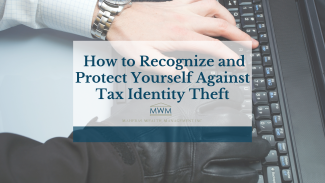
How to Recognize and Protect Yourself Against Tax Identity Theft
When you hear the term identity theft, the first thought that comes to mind may involve a data breach or opening a credit card in someone else's name. But another common type of identity theft involves the use of someone's Social Security number to unlawfully intercept their income tax refund. Unfortunately, this fraud often isn't discovered until the victim tries to file their taxes. Instead of getting a quick refund, they may instead be facing a lengthy battle with the IRS. Below we discuss some common signs of tax identity theft and how to protect yourself.
Guard Your Personal Information
Tax identity thieves don't need as much sensitive information as you might think. With little more than your full legal name and Social Security Number (SSN) ID thieves may be able to file a return using false income information to obtain a refund to which you're not entitled. One of the keys to preventing this fraud is minimizing the number of people who have access to your SSN. Don't provide your SSN to anyone over the phone, shred all documents containing this number (instead of throwing them away), and use multi-factor authentication to log into any online tax preparation accounts.
Check Your Credit Regularly
Although tax ID theft may not show up on your credit report, having other data breaches (like a stolen credit card number or accounts you don't remember opening) may increase your risk of this type of theft. Looking over your free credit report occasionally or signing up for credit alerts may tip you off to any other data vulnerabilities you may have experienced.
File Taxes Early When Possible
The quickest way to thwart a tax identity thief is to file your return first. If a would-be thief tries to file a tax return, but you've already submitted yours, theirs may not be processed—and you may get an IRS alert informing you of the attempt.
Recognizing Tax ID Theft
One early sign that your SSN may soon be used by an ID thief involves receiving a notice from the IRS informing you that a new online account was just created at IRS.gov. If you didn't make this account yourself, someone may be impersonating you with your personal information.
However, a common way this theft is recognized is after the fact, through a notification from the IRS when you try to file your return. If you file electronically, you may get a rejection message when you try to submit your return. If you file by mail, you may instead get a letter explaining that the IRS already received a return in your name. In either case, you may create a Federal Trade Commission (FTC) and IRS identity theft report by going to IdentityTheft.gov and following the instructions to create a claim. This allows the IRS to begin investigating to get to the bottom of your theft.
Important Disclosures:
The opinions voiced in this material are for general information only and are not intended to provide specific advice or recommendations for any individual.
This information is not intended to be a substitute for specific individualized tax advice. We suggest that you discuss your specific tax issues with a qualified tax advisor.
All information is believed to be from reliable sources; however LPL Financial makes no representation as to its completeness or accuracy.
This article was prepared by WriterAccess.
LPL Tracking # 1-05206790
Source:
https://www.consumer.ftc.gov/articles/what-know-about-tax-identity-theft

